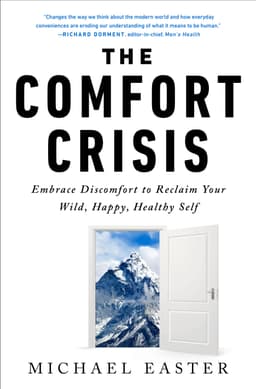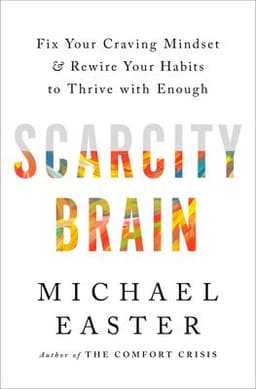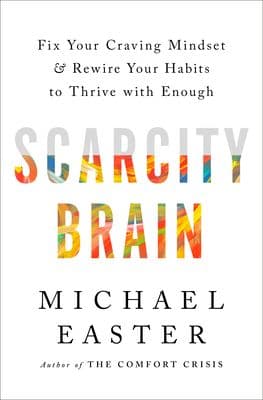
The Comfort Crisis Book Summary
Embrace Discomfort To Reclaim Your Wild, Happy, Healthy Self
Book by Michael Easter
Summary
In "The Comfort Crisis," Michael Easter investigates how our modern culture of constant comfort may be making us less resilient, more prone to illness, and robbing us of the very experiences that make us feel most alive.
Sign in to rate
Average Rating: 3.33
The Problem With Comfort
"Most people today rarely step outside their comfort zones. We are living progressively sheltered, sterile, temperature-controlled, overfed, underchallenged, safety-netted lives."
Section: 1, Chapter: 1
Prevalence Induced Concept Change
The author describes a psychology study where participants had to judge faces as either threatening or not threatening. As threatening faces became rarer, participants began perceiving neutral faces as threatening.
This "prevalence-induced concept change" or "problem creep" explains how when we experience fewer problems, we don't become more satisfied - we just lower our threshold for what we consider a problem. So even clearly black-and-white situations become gray, making us question our judgment. This has implications for how comfort creep affects us.
Section: 1, Chapter: 1
Comfort No Longer Moves Happiness
"Comforts and conveniences are great. But they haven't always moved the ball downfield in our most important metric: happy, healthful years."
Section: 1, Chapter: 3
Too Much Comfort Is Now Harming Us
For 99.996% of human history, our species lived with constant discomfort - too hot, cold, hungry, exposed to the elements, dealing with predators, injuries and diseases. Seeking comfort helped us survive. But in the last 0.004% of our history, we've suddenly been living with constant comfort thanks to modern innovations. Yet our brains are still wired for an uncomfortable world. So while comforts have allowed us to thrive, being overly comfortable is now linked with chronic diseases, mental health issues, lack of meaning, and fragility.
- Early humans lived intimately with discomfort to survive
- Comfort-seeking drove us to find food, build shelter, avoid risks
- But 99.996% of human history was pre-modern comforts
- In last 100 years, we now live with climate control, abundant food, sanitation, medicine
- Comfort creep means yesterday's comfort is today's discomfort
Section: 1, Chapter: 3
How "Problem Creep" Makes Solving One Issue Lead To Finding More
Psychologist David Levari conducted studies showing that when problems become rarer, we expand our definition of a "problem" to still find new ones. In one study, as threatening faces became less frequent, participants started deeming neutral faces as threatening. In another, as unethical research proposals became fewer, ambiguous proposals started seeming unethical.
This "prevalence-induced concept change" or "problem creep" happens unconsciously. As we experience fewer problems, we don't become more satisfied - we just move the goalposts. What used to be acceptable is now problematic. The same goes for comfort - as we get used to new comforts, our old comforts become unacceptable. Stairs were once a marvel, but now we need escalators. The problem creep phenomenon means solving issues doesn't necessarily make us happier, we just find new "problems."
Section: 1, Chapter: 4
Facing Challenges With A 50/50 Shot At Success Can Expand Your Limits
Sports scientist Marcus Elliott pioneered "misogi" challenges - grueling feats slightly beyond your limits, with two rules: "Make it really hard" and "don't die." You should have about a 50% chance of completing it. Repeatedly surfing your edge and sometimes failing shows you're capable of far more than you imagined. Examples of misogis Elliott and others have done:
- Moving an 85-pound rock underwater for 5km
- Stand-up paddleboarding 25 miles across the ocean
- Running the 46-mile rim-to-rim-to-rim route in the Grand Canyon
Neurological studies confirm that facing adversity with a high chance of failure activates a "toughening" effect - expanding your internal resources to handle new challenges with confidence.
Section: 1, Chapter: 6
Why Cities Make Us Lonely
Despite most modern people living in dense urban areas surrounded by other humans, nearly half of Americans report feeling lonely in what is being called a "loneliness epidemic." This is likely because cities violate our evolutionary preference for living in groups of around 150 people (Dunbar's Number) - the optimal community size that allowed us to thrive for most of human history.
But today a single city block can have thousands of people; human brains uneasy with population density that's too high. A lack of connection to people and place in cities breeds unhappiness
Rural, nature-connected people often report more life satisfaction In contrast, time in nature allows us to reset and experience the kind of intimate connections, sense of belonging, and timeless rhythms we evolved with.
Section: 1, Chapter: 8
Enduring Boredom While Hunting Leads To Insights On Attentional Capacity
The author realizes that thanks to smartphones and constant media, he almost never experiences true boredom anymore, and that his mind reflexively seeks distractions. Americans now spend 11 hours and 6 minutes per day on digital media.
But neuroscience shows that boredom serves a purpose - it shifts the brain into "default mode" where it can rest, wander, and subconsciously process information. The constant stimulation of modern life keeps us in an active attentional state, burning out our focus.
Allowing for boredom and lack of stimulation, ideally in natural settings, can calm an overactive mind, inspire creativity, and provide a sense of spaciousness lacking in modern life. Attention is a finite resource that requires periods of rest to function optimally.
Section: 1, Chapter: 11
Boredom Is A 'Desire For Desires'
Psychologist James Danckert explains that boredom serves an important function - triggering a desire for more satisfying activity. When our current actions aren't meeting our goals or fulfilling us, the sensation of boredom emotionally signals that it's time to change course.
However, the modern world offers an endless stream of easy, hollow solutions that don't actually resolve the underlying issue.
Boredom is meant to propel us toward meaningful action and growth, but we often opt for a quick dopamine hit instead. The key is learning to respond to boredom with creativity, reflection and intentional behaviors rather than mindless distraction. Allowing unstructured moments of mind-wandering, ideally in natural settings, opens the door to inspiration and renewal.
Section: 1, Chapter: 11
20-Minute Nature Break Can Enhance Creativity And Cognition
Spending just 20 minutes in a natural setting, three times per week, can measurably enhance cognitive function, problem-solving skills, and creativity. Brief nature immersions allow the brain to enter "soft fascination," a restorative state of engaged external awareness without the energy drain of directed attention. To maximize the benefits of a 20-minute nature break:
- Leave the phone behind to minimize distraction
- Walk in a park, greenway, nature preserve, or along a waterway
- Aim for three 20-minute nature sessions per week as a minimum therapeutic dose
Even if you live in an urban area, pockets of greenspace like parks, gardens and trails can provide a quick mental boost. Those lucky enough to have access to wilder natural areas can benefit even more from longer 3-5 hour sessions or multi-day wilderness immersions, which correlate with reduced stress, increased wellbeing and enhanced creativity.
Section: 1, Chapter: 12
Finding Peace In The Quiet Places
The author spends his final mornings in the Arctic savoring the profound silence and stillness found far from human-generated noise. In the modern world, it's nearly impossible to escape human-caused sound, which scientists have found increases stress hormones, reduces cognitive function, and fragments sleep.
An acoustic ecologist has calculated that there are only a dozen places left in the lower 48 states where you can go for 15 minutes without hearing human noise. But even reducing noise pollution and prioritizing natural soundscapes in parks and neighborhoods could provide a balm for overstimulated minds. Seeking out the quiet places, in nature and in ourselves, restores a forgotten form of peace.
Section: 1, Chapter: 13
The Surprising Benefits Of Feeling Hunger
After a week of stalking caribou with minimal food, the author experiences persistent, gnawing hunger - an unfamiliar sensation for someone used to constant access to calories. But the hunger also brings mental clarity and a kind of energized focus.
Neuroscience shows that hunger is a key driver of motivation, prompting humans to explore, learn, and take risks in pursuit of a goal. When we have effortless access to plentiful food, we dull that inner spark. Intermittent fasting, whether for 12-16 hours overnight or for whole days, has been shown to:
- Improve insulin sensitivity and promote fat burning
- Increase BDNF, a protein that enhances memory and learning
- Trigger autophagy, a cellular cleanup process that optimizes performance
- Boost mental clarity and ability to focus
Section: 1, Chapter: 14
The Dopamine Trap and Food
"In evolutionary terms, this property of palatable foods used to be advantageous in environments where food sources were scarce and/or unreliable because it ensured that food was eaten when available, enabling energy to be stored in the body (as fat) for future use. However, in societies like ours, where food is plentiful and ubiquitous, this adaptation has become a dangerous liability."
Section: 1, Chapter: 14
How Modern Eating Patterns Disrupt Ancient Biological Rhythms
Hunter-gatherers typically ate in a compressed window, going 12-16 hours between dinner and breakfast, with little to no snacking in between. But the modern eating cycle has expanded dramatically - the average person now consumes food for 15 hours of their waking day, with a 75% increase in snacking just since 1978.
This constant consumption runs counter to the body's evolved circadian rhythms. During a fasting period of 12-16 hours, the body shifts into a regenerative state called autophagy, breaking down old cellular debris and essentially "taking out the trash" to optimize function. But we short-circuit this process by keeping insulin elevated with frequent meals and snacks.
Most eating is now prompted by environmental cues like time of day or availability of treats, rather than actual physical need. Nutrient researcher Satchin Panda recommends limiting eating to a 10-12 hour window to restore healthy metabolic cycles, with benefits for glucose control, inflammation, cognition and cellular cleanup.
Section: 1, Chapter: 15
Confronting The Cosmic Calendar
Confronting mortality doesn't have to induce paralysis and depression - it can actually spur positive change. When we're aware of death, we're more likely to prioritize meaningful experiences, express gratitude, and connect with others. Thinking about our cosmic insignificance can render petty concerns laughably trivial.
But the experts caution that American culture has become death-phobic, sanitizing and concealing the realities of aging and dying. Spending time with the dying, openly discussing mortality, and facing the fragility of life are key to overcoming an unhealthy terror of the inevitable. Embracing memento mori, remembering we must die, can paradoxically enrich our time on earth.
Section: 1, Chapter: 17
How A Rucking Habit Can Enhance Strength And Cardio
To make "carrying the load" a more consistent practice, the author interviews the founder of GORUCK, an ex-Green Beret who promotes rucking as the ultimate full-body workout. Jason McCarthy defines rucking as walking with a weighted backpack at a decent clip, enough to get the heart rate up.
Rucking has a long history in military training and hunting/gathering, and is still the primary way Special Forces soldiers build endurance and mental toughness. But it's accessible to anyone. Experts recommend working up to carrying 20-50 pounds and going for 30-60 minute ruck walks multiple times per week, either with a weighted pack or weighted vest. Keeping the weight ≤50 pounds minimizes risk of injury while still providing ample physiological challenge.
Section: 1, Chapter: 20
The Mental Cost of Inactivity
"When faced with chronic inactivity over the lifespan, as is common in modern industrialized societies...[our] lack of either exercise in general or cognitive demands during exercise may lead to capacity reductions or suboptimal capacity maintenance in the brain similar to those seen in other organ systems....Our brains adaptively reduce capacity as part of an energy-saving strategy, leading to age-related brain atrophy."
Section: 1, Chapter: 20
Building Physical Resilience Through Discomfort Inoculation
After pushing through the pain and exhaustion of packing out his caribou, the author feels noticeably stronger and more capable. Where the first few miles utterly taxed him, by the end he finds a semblance of ease in the effort, tapping into new reserves.
He learns that 80% of people who train conventionally in the gym still fold on their first day in true backcountry conditions. Being fit isn't the same as being useful, durable and adaptable. The author realizes that what's missing in modern fitness is the regular inoculation of productive discomfort; intentional challenges that build the capacity to sustain long, grinding, full-body exertion without breaking down.
The author makes a vow to start cross-training his body and mind for the unknown and the uncomfortable. Not through sado-masochistic feats, but through practices that progressively, controllably nudge his thresholds. More long hikes with a pack. More time in the cold. More hauling awkward objects. Discomfort inoculation as a preventive discipline, rather than an emergency crash course.
Section: 1, Chapter: 21
Related Content


Scarcity Brain Book Summary
Michael Easter
In a world of abundance, our ancient scarcity-wired brains keep us trapped in self-defeating loops of "more" - but by recognizing these patterns and deliberately choosing "enough," we can find deeper fulfillment.
In a world of abundance, our ancient scarcity-wired brains keep us trapped in self-defeating loops of "more" - but by recognizing these patterns and deliberately choosing "enough," we can find deeper fulfillment.
Personal Development
Psychology
Habits
Human Behavior

